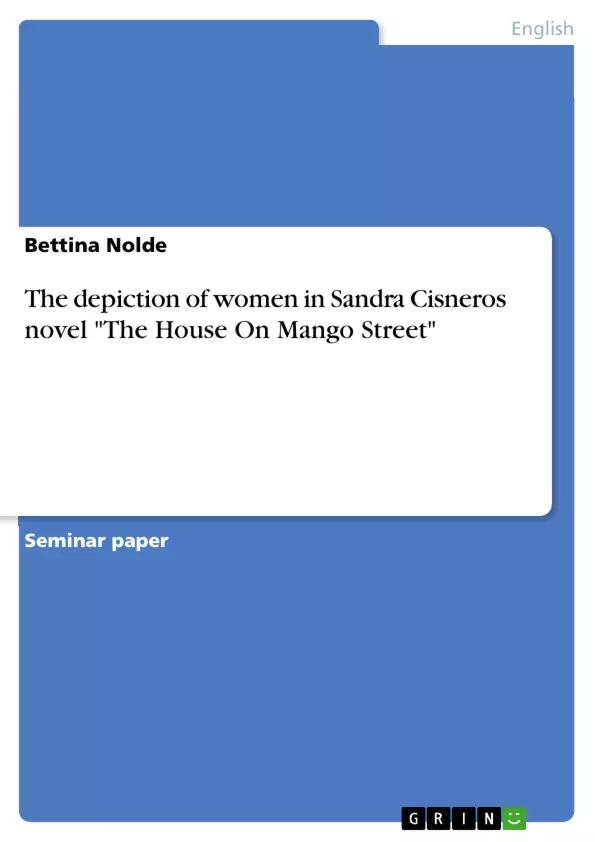Sandra Cisneros is one of the most popular feminist Chicana writers. She was born in
Chicago in 1954 as the only daughter among six brothers of a Mexican – American
mother and a Mexican father. In her early childhood the family moved a lot between
Chicago and Mexico City, where her grandparents lived, so Cisneros never felt at home
anywhere. Hence, she spent most of her time reading for the family’s mobility prevented
the development of friendships. When she attended college in 1974 she started writing
poetry and prose in a creative writing class. There she created a style of writing that was
intentionally opposite to those of her classmates. After receiving her M.A. at the
University of Iowa she worked in a Chicano barrio in Chicago teaching high school
dropouts and later on as an administrative assistant at Loyola University Chicago.
Today she lives in San Antonio and is working on a new novel.
In the following the depiction of women in her novel “The House on Mango Street” will
be examined. This novel consists of a series of vignettes describing the growing up of the
young girl Esperanza in a barrio in Chicago as she herself reflects it with her youthful
naivety. She characterises different people, particularly women respectively girls
surrounding her in various situations and depicts the living conditions of the barrio in
general.
The different female characters appearing in the novel will be analysed in reference to
their deprived situation concerning race, gender and class. To that end the author will
initially give an insight into the image and role of women in the Mexican – American
culture. Accordingly the analysis of the different characters acting in various situations
against the background of this will follow.
The literature used for this work is English as well as German whereas indirect quotations
from the German literature will be translated with the knowledge of the author.
Due to its limited extend the following work is not exhaustive.
Table of Contents
- Introduction
- The role of women in Mexican - American society
- Women in,,The House On Mango Street"
- Conclusion
- Literature
Objectives and Key Themes
This paper examines the depiction of women in Sandra Cisneros' novel "The House on Mango Street." The author aims to analyze the characters' experiences in the context of race, gender, and class, exploring the challenges faced by Chicanas in Mexican-American society. The work also delves into the complexities of feminist Chicana writing, highlighting its origins within the Chicano Movement and the criticism it faced.
- The role of women in Mexican-American society
- The experiences of Chicana women in a patriarchal system
- The intersection of race, gender, and class in shaping the lives of Chicanas
- The emergence of feminist Chicana writing and its critiques
- The portrayal of female characters in "The House on Mango Street"
Chapter Summaries
The first chapter introduces the author's focus on the depiction of women in Sandra Cisneros' "The House on Mango Street." It establishes the context of the novel and outlines the methodology of the analysis.
The second chapter explores the role of women in Mexican-American society. It examines the traditional hierarchical family structure and the expectations placed on women. The chapter also addresses the limitations and challenges faced by Chicanas in a society where male dominance and machismo are prevalent. The author provides examples of how these societal structures affect the lives of Chicanas.
The third chapter delves into the specific portrayal of women in "The House on Mango Street." The author analyzes various characters and their struggles, highlighting how their experiences reflect the broader societal context presented in the previous chapter. The chapter examines the novel's themes of poverty, discrimination, and the search for identity and empowerment.
Keywords
The primary focus of this work lies on the depiction of women in Sandra Cisneros' novel "The House on Mango Street," examining the intersection of race, gender, and class within the Mexican-American cultural context. Key themes include the role of women in a patriarchal society, feminist Chicana writing, the experiences of Chicanas in a male-dominated environment, and the exploration of female characters' struggles for self-determination and empowerment.
- Quote paper
- Bettina Nolde (Author), 2003, The depiction of women in Sandra Cisneros novel "The House On Mango Street", Munich, GRIN Verlag, https://www.grin.com/document/15382



